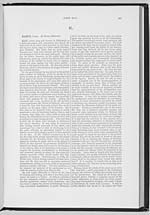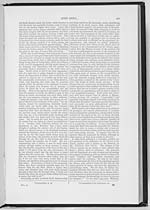Volume 2 > Half-Volume 4
(172) Page 416 - Keill, James
Download files
Individual page:
Thumbnail gallery: Grid view | List view

416 of so curious a chronicle. From the first to the last there is a remarkable similarity in his style. After forty years' experience he was just as deficient in grouping, and other acquired gifts in the art, as when he first began to use the graver. It would almost appear as if nature had designed him for that pecu- liar style alone in which he so much excelled all other men, and had denied him every common effect of his art, which other men generally attain with ease. In a profile of himself, executed about the year 1785, Mr. Kay appears with a handsome aquiline countenance, of much delicacy and ingenuity of ex- pression. In his latter days, when the writer of this notice first saw him, he was a slender but straight old man, of middle size, and usually dressed in a garb of antique cut; of simple habits, and quiet un- assuming manners. His head was of a singular structure, presenting a very remarkable protuberance in the forehead, where phrenologists, we believe, place the organs of observation : in Kay, the profile of this feature formed the arc of a perfect circle, be- ginning under the hair, and terminating at the root of the nose. According to the information of his widow (a second spouse, whom he married in 1787), he cared for and could settle at no employment except that of etching likenesses. He would sud- denly quit his lucrative employment in miniature- drawing in order to commit some freak of his fancy to copper, from which perhaps no profit was to be hoped for. It was the conviction of this lady, that if he had devoted himself to the more productive art he would soon have acquired a competency. Mr. Kay died in Edinburgh, some time in the year 1830. His wife survived him till 1835. After her death the copperplates of his works were purchased by Mr. Hugh Paton, Edinburgh, who republished them in two quarto volumes, with biographical sketches, under the title of Kay's Edinburgh Portraits. The work forms a collection altogether unique, and possesses great general as well as local interest, even in a generation comparatively unacquainted with the subjects of the prints, KEILL, JAMES, a physician and philosopher of eminence, the younger brother of the celebrated per- son whose memoir follows this in alphabetical order, was born in Scotland on the 27th of March, 1673. He received his early education in Edinburgh, after- wards studying the sciences and languages at Leyden and other continental universities. On his return to Britain he applied himself assiduously to the acqui- sition of a knowledge of anatomy, studying the science practically by constant attendance at the dissecting rooms. Having accustomed himself to deliver his opinions on anatomy privately to his friends, he at last undertook public tuition, and delivered with considerable applause lectures on anatomy at Oxford and Cambridge, by the latter of which universities he was presented with the degree of Doctor of Medi- cine. In 1698 he translated from the French, Lemery's Course of Chemistry, and soon after pub- lished in the Philosophical Transactions, "An Ac- count of the Death and Dissection of John Bayles of Northampton, reputed to have been one hundred and thirty years old."1 To No. 361 of the same journal he gave "De Viribus Cordis Epistola." In 1708 he published An Account of Animal Secretion, the Quan- tity of Blood in the Human Body, and Miiscular Mo- tion. On the subject of animal secretion, and the manner in which the fluids of the animal body are separated from the blood, he undertakes to show: I. How they are formed in the blood before they 1 Phil. Trans. xxv. 2, 247. come to the place appointed for secretion; 2. In what manner they are separated from the blood by the glands. Upon the former head he shows, " that the blood consists of a simple fluid, in which swim corpuscles of various figures and magnitudes, and endued with different degrees of attractive force. Hence he concludes, that of such particles as the blood consists of must the fluids be composed which are drawn from it. This he proceeds to show to be not only possible, but actually so in several secre- tions. From this principle, that the blood consists of corpuscles of various figures and magnitudes, and endued with various degrees of attractive power, &c., he attempts to show the force of the air upon the blood in breathing, in order to demonstrate that by the pressure of the air the cohesion of the globules of the blood is dissolved. After this he shows how the union of the attractive particles is hindered near the heart, and that the particles which unite first, after the blood is thrown out of the great artery, must be such as have the strongest attractive force; and that such as have the least, must unite last; and all the intermediate ones according to their respective attractive power."2 Besides this work, Keill pub- lished Anatomy of the Human Body, for the use of his pupils; and in 1717, Essays on Several Parts of the Human Economy. He appears to have given up public tuition, and some time previously to the publication of his last work to have established him- self as a practising physician at Northampton, where he gained considerable fortune and reputation, and remained till his death, which took place in July 16, 1719, from a cancer in his mouth. He was buried in the church of St. Giles, where his brother John, to whom he left his property, erected a handsome monument to his memory. KEILL, JOHN, an eminent mathematician and natural philosopher, the elder brother of the preced- ing, was born in Edinburgh on the 1st of December, 1671.3 He received the rudiments of education in the schools of his native city, and remained at the Edinburgh university until he was enabled to take the degree of Master of Arts. He early displayed a genius and predilection for mathematics, and had the good fortune to study the science, along with the Newtonian system of philosophy, under Dr. Gregory. When, in the year 1694, Gregory went to try his fortune in England, Keill followed him, and con- trived along with him to find admission to Oxford, where he held one of the Scottish exhibitions in Baliol College. Keill made his first appearance be- fore the scientific world in his Examination of Dr. Burnef's Theory of the Earth, together with some Remarks on Mr. Whistorf's New Theory of the Earth, published at Oxford in the year 1698. Any "theory of the earth," or account of its formation and state, in anticipation of the discovery of facts to support it, always formed a fruitful subject of debate; but Burnet's Theory afforded more ample field for cen- sure than any other which pretended to support from the enlightened doctrines of modern philosophy. The grand outlines of his theory were of themselves suffi- ciently imaginative, and their effect was increased by the curious speculations with which he filled up the minor details of his edifice. He supposes the earth to have been originally a heterogeneous mass of fluid matter, of which the heavier portions fell to the centre, forming there a dense body, surrounded and coated by lighter bodies, while the water�the lightest of all the heterogeneous mass�remained on the outside of the whole. The air and other celes- 2 Martin's Biographia Philosophica, 460. 3 Ibid. 457.
Set display mode to:
![]() Universal Viewer |
Universal Viewer | ![]() Mirador |
Large image | Transcription
Mirador |
Large image | Transcription
Images and transcriptions on this page, including medium image downloads, may be used under the Creative Commons Attribution 4.0 International Licence unless otherwise stated. ![]()
| Biographical dictionary of eminent Scotsmen > Volume 2 > Half-Volume 4 > (172) Page 416 - Keill, James |
|---|
| Description | Spine title: Half-Vol. IV. Heriot to Lynedoch. |
|---|---|
| Description | Volume II. Contains names alphabetically from Falconer to Lynedoch. |
|---|

